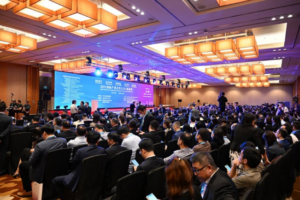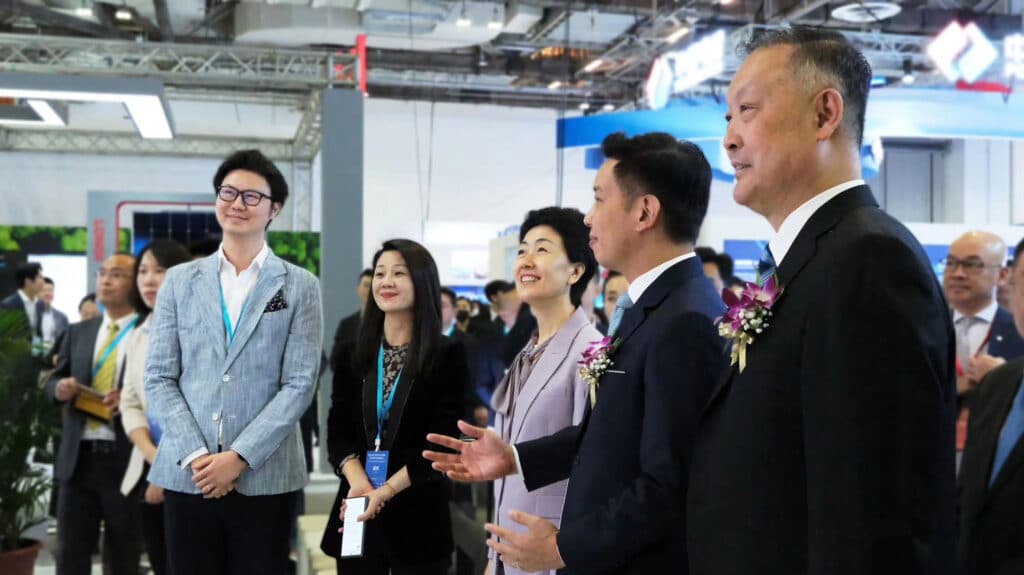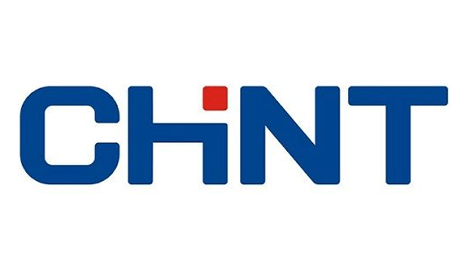CHINT – CHINT Attended the China Mechanical and Electrical Exhibition 2023 Event
 On March 22, CHINT was invited to attend the China Mechanical and Electrical Exhibition 2023 Event. The conference was held at the Marina Bay Sands Conference and Exhibition Center in Singapore.
On March 22, CHINT was invited to attend the China Mechanical and Electrical Exhibition 2023 Event. The conference was held at the Marina Bay Sands Conference and Exhibition Center in Singapore.
With the theme of “Green Development, Digital Drive, Land and Sea Channel, Diversified Finance, and Intelligent Manufacturing,” more than 600 representatives from international organizations, industry associations, financial institutions, and companies from RCEP countries attended the conference. The conference witnessed the establishment of the dual-carbon platform.
Chinese Vice Minister of Commerce and Deputy Representative for International Trade Negotiations, Ling Jihua, Singapore Minister for Trade and Industry, Chan Chun Sing, Chinese Ambassador to Singapore, Sun Xueling, Deputy Director-General of the World Trade Organization, Zhang Xiangchen, Executive Vice Governor of Fujian Province, Guo Ningning, President of the Singapore Chinese Chamber of Commerce & Industry, Roland Ng, Chairman of the China Chamber of Commerce for Import and Export of Machinery and Electronic Products, Zhang Yujing, Representative of the Thai-Chinese Business Council, Huang Chunshun, and Chairman of China State Construction Engineering Corporation, Zheng Xuexuan, attended the opening ceremony of the 2023 International Industrial Cooperation Conference (Singapore) and China Machinery and Electronic Products Brand Exhibition on March 22nd at the Sands Expo and Convention Centre in Singapore.
The conference, with a theme of “Green Development, Digital Drive, Land-Sea Corridor, Diversified Finance, and Intelligent Manufacturing,” attracted more than 600 representatives from international organizations, industry associations, financial institutions, and enterprises in the RCEP region.
In her speech, Chinese Ambassador to Singapore, Sun Xueling, stated that China’s efforts to boost the economy have given a strong boost to confidence and enthusiasm for cooperation with China, particularly in the field of the real economy and manufacturing.
The International Industrial Cooperation Conference provides a platform for a deeper understanding of China’s real economy and manufacturing industry, and she hopes that all parties can seize the opportunity to promote cooperation.
The opening ceremony was chaired by Executive Vice Chairman and Director of the Expert Committee of the China Chamber of Commerce for Import and Export of Machinery and Electronic Products, Zheng Chao.

During the opening ceremony, a signing ceremony and achievement release ceremony were held. As one of the first participating corporate representatives, CHINT Global witnessed the signing and release of a series of international and platform-based cooperation achievements, including the “Joint Action Plan for Promoting Green Development,” “Memorandum of Cooperation on Establishing an International Industrial Cooperation Service Platform,” and the “China Machinery and Electric Industry ‘Dual Carbon’ Information Disclosure Platform.”
The latter is developed to help Chinese machinery and electric companies meet various green and low-carbon compliance requirements, achieve green transformation, and provide a smart platform for Chinese companies to “go global” in the context of carbon peaking and carbon neutrality goals.
Johnson Luu, Director at CHINT APAC shared at the event about intelligent manufacturing. “Intelligent manufacturing plays a crucial role in supporting the accelerated pace of digitalization. The speed of production and implementation, and the use of superior quality smart energy products, work together in meeting the accelerated demand for power-to-plug solutions.
Today, CHINT is one of the largest producer of circuit breakers – producing up to 3 million circuit breakers daily to serve the needs of the world. We have built the factory of the future, and we will continue to improve the structure of energy production and consumption.
We will push the boundaries of innovation to grow our intelligent manufacturing expertise, grow in tandem with technological advances, and work towards building zero carbon factories”, says Johnson.
Source
CHINT Global
EMR Analysis
More information on CHINT: See the full profile on EMR Executive Services
More information on Nan Cunhui (Chairman, CHINT Group): See the full profile on EMR Executive Services
More information on Lily Zhang (Executive President, CHINT Electrics and President, CHINT Global): See the full profile on EMR Executive Services
More information on Johnson Luu (Marketing Director APAC, CHINT Global): See the full profile on EMR Executive Services
More information on Ling Jihua (Vice Minister of Commerce and Deputy Representative for International Trade Negotiations, China): http://lingji2.mofcom.gov.cn/
More information on Guo Ningning (Vice Governor of Fujian Province, China): https://fj.qq.com/a/20181123/012829.htm
More information on Chan Chun Sing (Minister for Trade and Industry, Singapore): https://www.pmo.gov.sg/cabinet/mr-chan-chun-sing
More information on World Trade Organization (WTO): https://www.wto.org/index.htm + The World Trade Organization (WTO) is the only global international organization dealing with the rules of trade between nations. At its heart are the WTO agreements, negotiated and signed by the bulk of the world’s trading nations and ratified in their parliaments. The goal is to ensure that trade flows as smoothly, predictably and freely as possible.
The primary purpose of the WTO is to open trade for the benefit of all. The WTO has many roles: it operates a global system of trade rules, it acts as a forum for negotiating trade agreements, it settles trade disputes between its members and it supports the needs of developing countries.
More information on Ngozi Okonjo-Iweala (Director General, WTO): https://www.wto.org/english/thewto_e/dg_e/dg_e.htm
More information on Zhang Xiangchen (Deputy Director-General, WTO): https://www.wto.org/english/thewto_e/dg_e/ddgs_e.htm
More information on China Chamber of Commerce for import and Export of Machinery and Electronic Products (CCCME): https://www.cccme.cn/cp/about/profile.aspx + Founded in July of 1988, China Chamber of Commerce for Import and Export of Machinery and Electronic Products (hereinafter as CCCME), is a nationwide industrial and nonprofit organization, formed jointly and voluntarily by various economic organizations engaged in manufacturing, import and export, overseas turnkey project contracting and other related activities in machinery and electronic industry.
More information on Zhang Yu jing (President, CCME): https://www.cccme.cn/cp/about/leader.aspx
More information on Zheng Chao (Executive Vice President, CCME): https://www.cccme.cn/cp/about/leader.aspx
More information on the International Industrial Cooperation Conference (22-23 March 2023 | Singapore): https://www.sccci.org.sg/event/detail?slug=2023-conference-on-international-industrial-cooperation-singapore + International Industrial Cooperation Conference aims to enhance economic and trade cooperation between China, Singapore and RCEP countries through discussions on green development, digital empowerment, diversified finance, and intelligent manufacturing.
EMR Additional Notes:
- RCEP Countries (Regional Comprehensive Economic Partnership):
- RCEP is a regional free trade agreement that complements and builds upon Australia’s existing free trade agreements with 15 other Indo-Pacific countries.
- Fifteen countries signed RCEP in 2020. These countries include the 10 members of the Association of Southeast Asian Nations (ASEAN) :
- Brunei-Darussalam
- Cambodia
- Indonesia
- Laos
- Malaysia
- Myanmar
- Philippines
- Singapore
- Thailand
- Viet Nam
- Plus five regional countries with which ASEAN has free trade agreements:
- Australia
- China
- Japan
- South Korea
- New Zealand
- Switchgears:
- Performs the function of controlling and metering the flow of electrical power in addiction to acting as interrupting and switching devices that protects the equipment from damage arising out of electrical fluctuations.
- Circuit Breakers:
- Mechanical electrical switch to protect electrical circuit against short circuit or overload.
- Fuses:
- Single time mechanical circuit interruption in an over-current situation through fusion of a graded electrical conductor. Employed in 30KV to 100KV range.
- ACB:
- Air Circuit Breakers: Uses air as insulating medium.
- VCB:
- Vacuum Circuit Breakers: Vacuum is used as the means to protect circuit breakers.
- GIS:
- Gas Insulated Switchgears: All working components assembled under SF6 (Sulfur Hexafluoride HV Switchgears) gas-tight casing.
- OCB:
- Oil Circuit Breakers: Vapors a portion of oil to blast a jet of oil through the arc.
- Hybrid:
- Combines Air-insulated and SF6 Gas-insulated technologies.
- MCB:
- Miniature Circuit Breakers: employed in domestic households to safeguard against overload. Rated current max. 100 A.
- RCCB:
- Residual Current Circuit Breakers: to safeguard against electrical shock arising out of indirect contact and includes the detection of residual current such as earth leakage.
- MCCB:
- Molded Case Circuit Breakers: Incorporates insulating material in the form of molded casing within circuit breaker. Rated current up to 2,500 A.
- Disconnectors:
- Automatic switching device that offers specific isolating distance on the basis of specific requirements.
- Contactors:
- Works alike high-current switching systems but at higher voltage rates. Contactors can however not be utilized as disconnecting switches. Contactors are employed in 30KV to 100KV range.
- Carbon Dioxide (CO2):
- Primary greenhouse gas emitted through human activities. Carbon dioxide enters the atmosphere through burning fossil fuels (coal, natural gas, and oil), solid waste, trees and other biological materials, and also as a result of certain chemical reactions (e.g., manufacture of cement). Carbon dioxide is removed from the atmosphere (or “sequestered”) when it is absorbed by plants as part of the biological carbon cycle.
- Decarbonization:
- Reduction of carbon dioxide emissions through the use of low carbon power sources, achieving a lower output of greenhouse gasses into the atmosphere.

